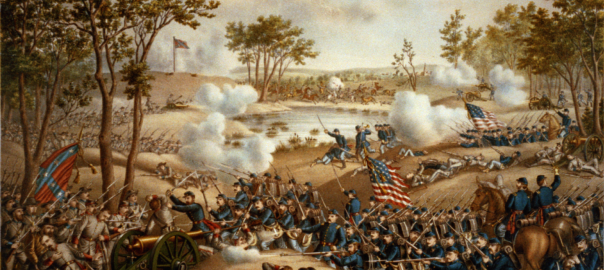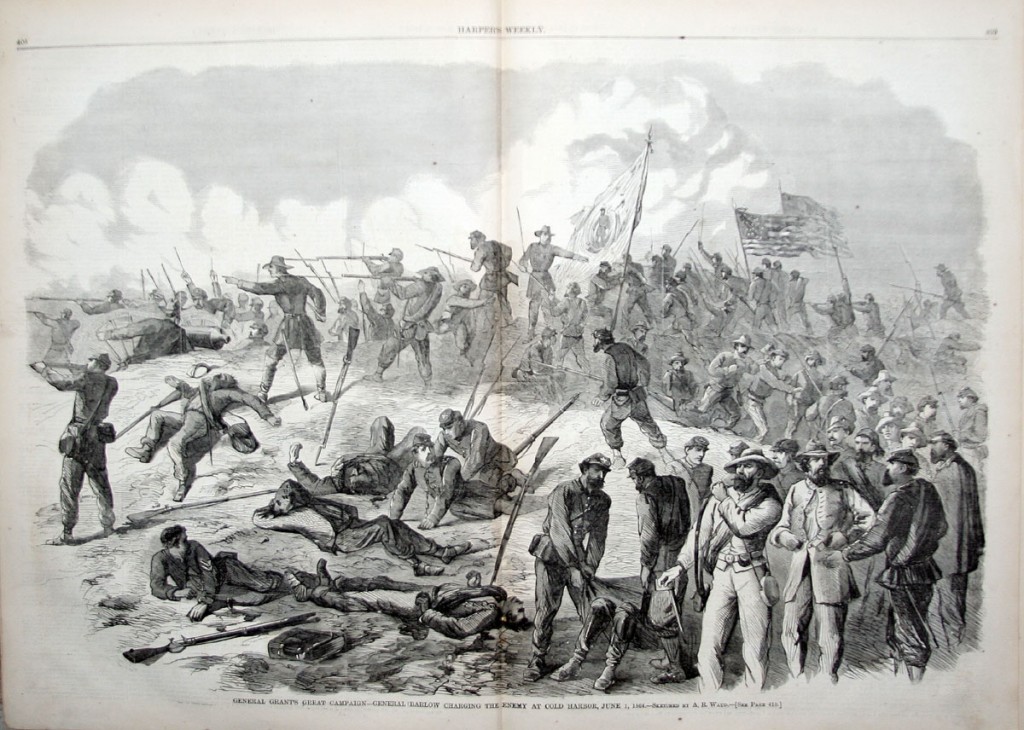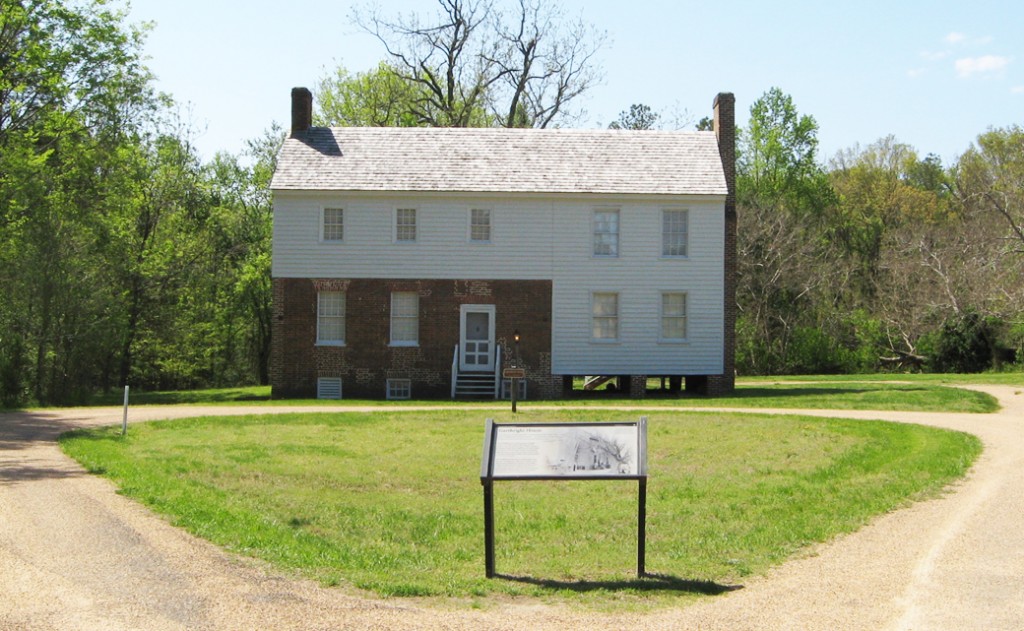Posted on August 15, 2017
6. COLD HARBOR BATTLEFIELD – MECHANICSVILLE, VIRGINIA
Cold harbor battlefield – Soldiers killed during one of the nation’s bloodiest battles make unsettled spirits.

Image Source: Wikipedia
Since the sole purpose of cemeteries is to house the dead, it makes sense that most people think that they are the only places spirits like to take up residency. But Colonial Ghosts has done the research – it’s those whose bodies were never properly interred who are the most restless. That’s why on their guided ghost tours through Colonial Williamsburg, destinations don’t just include graveyards and burial grounds, but old colonial mansions, hospitals, prisons… and everything in between.
From abused slaves to murdered colonists, the dead that haunt Williamsburg don’t just stick around their graves. Tourists have encountered a wide variety of spirits during one of Colonial Ghosts’ chilling walks. But some of the apparitions most frequently seen are definitely those of soldiers – not a huge surprise, given Virginia’s important role in both the Civil and Revolutionary Wars. In fact, the state is home to one of the nation’s most haunted military sites: Cold Harbor Battlefield.
Located in Mechanicsville (about a fifty minute drive northwest of Williamsburg), Cold Harbor Battlefield is where “one of American history’s bloodiest, most lopsided battles” occurred. It was a part of Union Lieutenant General Ulysses S. Grant’s Overland Campaign, also known as the Wilderness Campaign. Though the strategic operation included many raids and skirmishes, the Battle at Cold Harbor was particularly disastrous and grisly. Grant himself would later reflect:
“Cold Harbor is, I think, the only battle I ever fought that I would not fight over again under the circumstances. I have always regretted that the last assault at Cold Harbor was ever made.”3
A priest who was at the battle, Winthrop Phelps, confirms:
“You cannot conceive the horror and awfulness of a battle. I never wish to hear another much less see it. I went out to see this but found myself in such danger I soon fled… Pray for me. I cannot write – am not in a fit state of mind…”4

Image Source: Sonofthesouth.net
The Battle of Cold Harbor was a long one – it lasted from May 31 to June 12, 1864. Perhaps the land on which it occurred was just destined to claim lives – in 1862, another skirmish of similar intensity, the Battle of Gaines’s Mill, took place on the site. “By late June 1862, Gaines’ Mill was the second bloodiest battle in American history.”5
At the start of the Battle of Cold Harbor, Grant forces totaled around 109,000 men; his opponent, General Robert E. Lee, had 59,000 Confederates under his command. Despite going in with more soldiers, Grant was unable to secure a Union victory. To be sure, things had started off in Grant’s favor; fresh from his success at Old Church, Grant was able to capture Cold Harbor, a pivotal junction northeast of Richmond.
On May 31, he ordered a small cavalry division to further reinforce the crossroads. But lack of coordination among his officers and General Lee’s ability to fashion “the most ingenious defensive configuration the war had yet witnessed”6 made it hard for Grant to retain Cold Harbor. Moreover, the land itself was very unforgiving; its difficult terrain made trench warfare a hot and miserable experience for both sides.
Lack of medical assistance meant dugouts were cramped with both the living and the dead; limited food and water meant dehydrated soldiers fought on empty stomachs. Just imagine trying to load and reload your rifle, with dead bodies in the way! No wonder many who have visited the battlefield claim to have experienced an overwhelming sense of anguish and sorrow.
The Union army made little progress from June 1st to June 2nd. Grant was overly eager in his strategy, often sending out orders without first ensuring that his officers had enough men to carry out his plans. This gave General Lee ample time to further bolster his defenses. June 3rd was an especially devastating day; in under an hour, around 7,000 of Grant’s men were slaughtered. On a blood stained diary entry, one Union fighter writes: “June 3. Cold Harbor. I was killed.”7
Word had spread of the battle’s gruesomeness; Civil War photographers made frequent trips to the site, both during and after the conflict. Below, you can see why the battlefield’s ghosts are so unsettled; they’re comrades never had the time to dig them proper graves.

Image Source: Nps.gov
Though the Confederates emerged from the Battle of Cold Harbor as its ultimate victors, triumph had not come easily. When the two beleaguered armies finally separated, their losses totaled up to 4,595; Union casualties were even more upsetting, estimated to be 12,737.8 And decades after the Civil War, these killed, wounded, and never found continue to remind the living of what they went through. Writes paranormal investigator, Beth Brown:
“I thought sure that the reports of paranormal happenings at Cold Harbor had something to do with the strong emotions of the men who lost their lives there over a century ago. Locals and visitors alike claim to have felt the booms of artillery fire, smelled the distinct scent of burned gunpowder, heard shouts and cries from unseen men, the heavy clamor of horses’ hooves…”9
Brown wanted to experience the haunted battlefield for herself; wisely, she included a park policeman, Barry Krieg, on her team of ghost hunters, because something was definitely stalking them on that memorable night.
Besides hearing footsteps behind them, the team also came across what many others have encountered on the battlefield: a dense, unexplainable fog, which disappears as quickly as it manifests. The Sykes couple10 had a particularly scary experience – drawn to the site by ghostly cannon fire, they attempted to snap some photos, before an unsettling sense of being watched and the sudden, spectral mist drove them away.

Image Source: History.net
Perhaps these fogs are remnants of thick gun smoke, or even “a portal to the past.”11The latter would certainly explain historian and paranormal investigator Mark Nesbitt’s strange experience at Cold Harbor Battlefield:
“I got to the highest point of the arched bridge and suddenly was stopped. I didn’t stop; I was stopped and looked to my left down into the remnant of the Confederate trench. I heard myself say, “Something awful happened to me right here.”
I didn’t think it, I said it out loud. […] Did this have some to do with reincarnation? To unconsciously blurt out that something terrible happened to me right at a specific spot where I had never been before – at least in this life – is incomprehensible to me.”12
Others have left the battlefield with stories of brief possession. One man, upon reaching the spot where Colonel Tomkins is believed to have been shot in the head by a well-aimed minie ball, felt an excruciating pain to his own skull.
Cold Harbor Battlefield is a part of Richmond National Battlefield Park. Unfortunately, much of the 7,500 acre battlefield has been changed to support commercial and residential activities – by 2007, only 300 some acres remained. The Hanover County Board of Supervisors, faced with a housing density problem, put preserving the historic site on the backburner. As a result, Cold War Battlefield was added13 to the Civil War Preservation Trust’s 2008 list of Ten Most Endangered Battlefields.
The National Park Service has done much to stave off any further changes to Cold Harbor Battlefield; the site is included in the American Battlefield Protection Program. Thanks to the bureau’s efforts, much of the site’s elaborate trench system (nearly seven miles long!) and other earthen breastworks remain well intact.
The Richmond Battlefields Association, another organization, has also joined the fight to preserving the battlefield’s acres. It made a particularly important contribution in the spring of 200814, rescuing a plot from being sold to private landowners.
Today, the haunted landscape has huge tourist appeal; along its improved trail system, picnic tables and historical signage have been added. One of the best things about the park’s tour15 is that it ends with two eerie extras: Cold Harbor Cemetery and the Garthright House. Both locations are rumored to be haunted by a little girl.

Image Source: Uploaded by BrotherO to Trip Advisor
The cemetery was built in 1866 and has undergone numerous changes. Grave markers have been updated to marble, for instance, and the old, wooden cottage where the keeper stayed has been replaced by a more accommodating brick lodge. Three impressive granite monuments have also been erected. Since many of the soldiers from the battle could not be identified, The Tomb of the Unknown Soldier and The Pennsylvania Monument commemorate those who remain nameless.
The 8th New York Heavy Artillery Monument, built in 1909, manages to both honor and name the deceased. It lists the 219 men of the regiment on a bronze plaque stamped onto an eleven foot block of granite.

Image Source: Stone Sentinels
The Garthright House is a single family dwelling that dates back to the 1700s. But in the eyes of Confederate and Union officers, the two-story structure was the perfect place to set up a makeshift hospital. According to one of its wayside markers16, Union surgeons took over the home in June 1864, and the poor Garthright family was forced to take refuge in the basement.
You can just imagine what horrific sounds they heard from above their heads: soldiers, crying out in pain; doctors, throwing out orders for limbs to be removed or saved… sometimes, blood would even seep and splatter down into the cellar. At the end of the ordeal, some 97 soldiers could not be rescued, and had to be unceremoniously buried under the front lawn. Perhaps the little girl who haunts the house is one of the Garthright children; only in death can she finally freely roam her childhood home.

Image Source: Stone Sentinels
Works Cited
- Stevens, Robert. The Bracken Rangers: Company K, 28th Regiment, 1st Indiana Cavalry, and Essays on the American Civil War. Miami, Los Angeles: Three Stars Press. 2010, Revised August 2011. Page 389.
- Miller, Francis Trevelyan and Robert Sampson Lanier. The Photographic History of the Civil War … The decisive battles. Springfield: Patriot Publishing Co. 1911. Page 82.
- Furgurson, Ernest B. Not War, But Murder: Cold Harbor 1864. New York: Random House, Inc. 2000. Page 102.
- “Ten Facts about the Battle of Gaines’ Mill.” Civil War Trust. Civil War Trust, 2014. Web. 1 September 2015. Para. 3.
- “June 2: Grant Delays.” Civil War Series: The Battle of Cold Harbor. National Park Service, U.S. Department of the Interior. Last updated 2 September 2015. Web. 1 September 2015. Para. 5.
- Furgurson, Ernest B. Not War, But Murder: Cold Harbor 1864. New York: Random House, Inc. 2000. Page 178.
- “Battle Facts.” Cold Harbor – Facts And Resources. Civil War Trust, 2014. Web. 30 August 2015.
- Condra, Amy. “Looking for ghosts at Cold Harbor.” Richmond Times-Dispatch. 13 May 2008. Web. 30 August 2015. Para. 3.
- Nesbitt, Mark. Civil War Ghost Trails. Mechanicsburg: Stackpole Books. 2012. Page 169.
- Nesbitt, Mark. Civil War Ghost Trails. Mechanicsburg: Stackpole Books. 2012. Page 169.
- Nesbitt, Mark. Civil War Ghost Trails. Mechanicsburg: Stackpole Books. 2012. Page 170-171.
- Kerr, Jennifer C. “Group: historic battlefields threatened.” USA Today. 2008 March 12. Web. 30 August 2015. Para. 8.
- On Richmond’s Front Line. Richmond Battlefields Association Official Newsletter. Volume 12, Number 1. Richmond Battlefields Association. Spring 2013. Web. 30 August 2015. Page 1.
- “Touring Cold Harbor Battlefield.” Richmond National Battlefield Park. National Park Service, U.S. Department of the Interior. Last updated 2 September 2015. Web. 1 September 2015.
- “Garthright House wayside marker.” Stone Sentinels. Steve Hawks, 2007-2015. Web. 1 September 2015.

